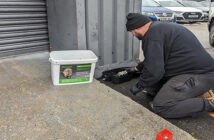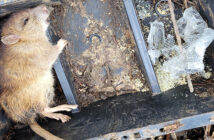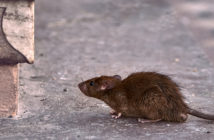Published on 22 November, a discussion document prepared for the Directorate-General Environment of the European Commission reveals a disturbing direction of thought concerning the use of second generation anticoagulant rodenticides (SGARs). If implemented this recommended use would pose severe and impractical restrictions for rodent control across Europe.
Readers will be aware, through the pages for Pest magazine for example, that there has been considerable lobbying by the pest control industry to broaden the use of these SGARs (bromadiolone, difenacoum, brodifacoum, flocoumafen and difethialone). Only as recently as September 2011, it did seem there was a glimmer of hope that the position would change – see Pest Issue 17 September & October 2011 article – click here to view.
|
However, it appears from proposals put forward in this recent document prepared for DG Environment for presentation to the Product Authorisation & Mutual Recognition Facilitation Group (PA&MRFG) that any progress thought to have been made may well be short-lived. In essence, this 18 page document covers four proposed ways forward in a bid to unify at Member State level the use of the products containing SGARs. At best, the proposals retain the status quo and, at worst, are marked steps backwards and pose severe practical problems. Proposal 1 – restrict use of all SGARs to indoors only |
|
|
|
Proposals 1 and 4 are in effect very similar, as use of potent SGARs would be restricted to indoors only. Proposal 3 is where we are at present. Proposal 2 is what the industry has been lobbying for and on the face of it might appear favourable. But several adverse comments are recorded declaring concerns surrounding environmental impact which would arise by extending use over Proposal 3. All four proposals fail to take into account the problems encountered of controlling resistant rats outdoors should the use of brodifacoum, flocoumafen and difethialone not be allowed. This would mean that there would be whole stretches across Europe where rat control was not achievable. Further restrictions are put forward which would significantly alter methods of rodenticide application – for example grain baits, pellets and liquids would be restricted to indoor use only – meaning wax baits only could be used outdoors. Alan Buckle, Chairman of the Rodenticide Resistance Action Group, said: “It is disappointing that the growing difficulty of rat control in many Member States caused by anticoagulant resistance is largely overlooked in this document. If some of the proposals are adopted, it would become impossible to control rats over large parts of Europe. This is obviously unacceptable but has not stopped the authors of this document putting it up for consideration. We can only hope that good sense prevails at the PA&MRFG meeting next month.” This paper is to be debated at the forthcoming PA&MRFG meeting on 6 December in Brussels. The pest control industry is currently seeking the views of its members. To find out more, or to make your views known, contacting industry trade associations is recommended. Footnote To appreciate the situation a brief note on the background to the position is required. The SGARs (bromadiolone, difenacoum, brodifacoum, flocoumafen and difethialone) are now included on Annex 1 of the Biocidal Products Directive. From this Mutual Recognition, i.e. identical approved use, at Member State level should follow. This has not been the case. Although, as its name suggests, the PA&MRFG was set up to ensure this happens. In the Annex 1 process, risks were identified to humans, non-target animals and the environment which would normally prevent Annex 1 inclusion, but due to the public health benefits and the lack of established alternatives, these rodenticides were included. But, the final decision regarding how and where they could be used was delegated to Member States. It was agreed that: “Member States will be able to make restrictions at the product authorisation stage….. which can go further than the risk mitigation measures explicitly set out in Annex 1. Such measures could include specific restrictions on outdoor use, or even a ban on such use, if such restrictions appear appropriate for sound scientific reason.” In the UK, for example, this has meant that despite official approval at EU level for use of brodifacoum, flocoumafen and difethialone ‘in and around buildings’ this has not been sanctioned in the UK. |
||




